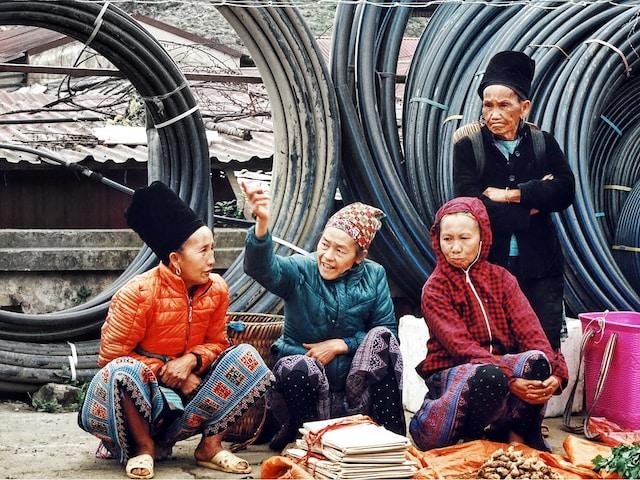Ha Giang Travel Guide: Waterfalls, Caves, and Natural Wonders
Welcome to Ha Giang, a mesmerizing province in northern Vietnam that beckons with its rugged landscapes and cultural diversity. While the region is renowned for its breathtaking trekking opportunities and vibrant hill tribe villages, it also harbours a plethora of hidden gems that captivate the senses and stir the soul. Cascading Splendor: Ha Giang’s Enchanting Waterfalls Ha Giang’s terrain is adorned with stunning waterfalls that cascade gracefully from lofty heights, creating picturesque scenes that seem straight out of a fairytale. Our first stop is at Thac Tien Waterfall. The sight and sound of the rushing waters are sure to leave you in awe. Next, we venture to Lung Cu Viewpoint, a gem nestled amid the verdant hills of the Dong Van Karst Plateau riddled with multiple waterfalls. Lung Cu Viewpoint offers a tranquil escape from the hustle and bustle of city life, surrounded by pristine nature and idyllic landscapes. The serene atmosphere invites visitors to take a refreshing dip in the natural pools formed by the cascading waters. Continuing our waterfall exploration, we reach the breathtaking Ban Gioc Waterfall. Straddling the border between Vietnam and China, this majestic waterfall is one of the largest in Asia. Its multi-tiered cascade, thundering down the lush mountainside, creates a spectacle of natural grandeur that must be witnessed firsthand. The surrounding karst formations and emerald green pools add to the allure of Ban Gioc, making it a must-visit destination in Ha Giang. Unravelling Mysteries: Ha Giang’s Mysterious Caves Ha Giang’s rugged landscapes are dotted with fascinating limestone caves, each holding its own mysteries and historical significance. One such cave is Lung Khuy Cave, located in Quan Ba district. It is famous for its intriguing stalactites and stalagmites formations, resembling a captivating work of art created by nature itself. Exploring the cavernous chambers of Lung Khuy Cave is like stepping into a mystical realm of wonder. The journey to Ha Giang’s hidden gems would be incomplete without visiting Dong Van’s Vuong Palace Cave. This cave served as the residence of the Hmong King Vuong Chinh Duc during the French colonial period. Today, it stands as a fascinating testament to the region’s history and architectural heritage. Visitors can wander through the palace’s chambers, admiring its intricate carvings and cultural artifacts that narrate the tales of the past. Another remarkable cave is Nui Doi Cave, or Double Mountain Cave, located in Meo Vac district. As its name suggests, the cave is nestled between two towering limestone mountains, forming an otherworldly landscape. Nui Doi Cave is adorned with impressive stalactites and stalagmites, forming unique shapes that spark the imagination of those who venture inside. Nature’s Artistry: Ha Giang’s Awe-Inspiring Natural Wonders Ha Giang’s hidden gems extend beyond waterfalls and caves, encompassing a myriad of natural wonders that will leave you spellbound. Our first stop is at Ma Pi Leng Pass, often dubbed the “King of All Passes.” This mountain pass offers panoramic views of the Nho Que River, winding through deep canyons and limestone peaks. The road atop Ma Pi Leng Pass provides breathtaking vistas, making it a photographer’s paradise. Next, we head to Lung Cu Flag Tower, standing tall at the northernmost point of Vietnam. The tower is perched atop Lung Cu Peak, providing a stunning panoramic view of the surrounding landscape and neighbouring China. It is also a symbolic representation of the country’s sovereignty and ethnic unity. Our journey concludes at Quan Ba’s Fairy Bosom Twin Mountains, known locally as “Nui Co Tien.” These twin peaks rise dramatically from the earth, their shapes resembling two breasts, giving rise to the name “Fairy Bosom.” Local folklore narrates a romantic tale of the mountains, adding a touch of mystique to the scenic wonder. Motorbike adventures on the Ha Giang Loop Arguably the most popular attraction in Ha Giang, the 3 day loop takes you to the most breathtaking destinations of the region. Check our our full blog on the Ha Giang Loop for more information! Ha Giang’s hidden gems beckon adventurers and nature enthusiasts to explore the lesser-known wonders of this captivating province. From the enchanting waterfalls that glisten in the sunlight to the mysterious caves that hold the secrets of the past, and the awe-inspiring natural wonders that leave us humbled, Ha Giang’s hidden gems offer an unparalleled escape into the lap of nature’s artistry. As we bid farewell to this extraordinary journey, may you be inspired to tread off the beaten path and discover the treasures that Ha Giang has in store, ready to weave its magic upon all who seek its hidden wonders.




